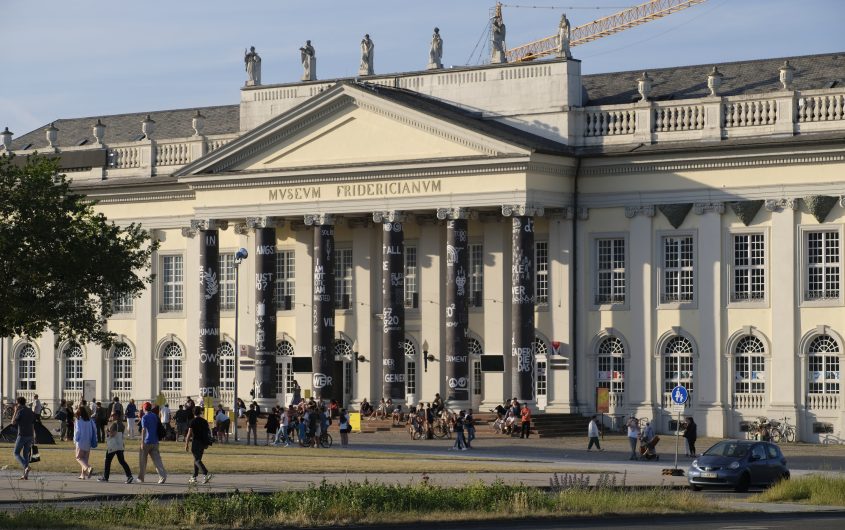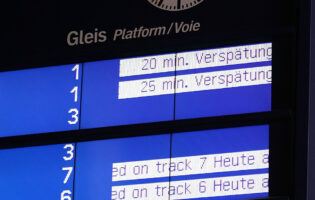
Birte Fritsch via Flickr
Documenta 15 and Anti-Semitism

Mark W. Rectanus
Iowa State University
Mark W. Rectanus is University Professor of German Studies (Emeritus) in the Department of World Languages and Cultures at Iowa State University. He received his Ph.D. from Washington University in St. Louis and completed his dissertation on paperback series in Germany as a Fulbright Scholar at the University of Munich. Professor Rectanus has been a visiting professor at The Ohio State University and an Alexander von Humboldt Foundation Research Fellow at the University of Munich. His publications include research on the German publishing industry, the book and electronic media, contemporary German literature, corporate sponsorships, cultural politics, museum studies, and contemporary art. Much of his research addresses the globalization of culture, including his book Culture Incorporated: Museums, Artists, and Corporate Sponsorships (University of Minnesota Press), and the impact of globalization on contemporary museums. He has published numerous articles, including essays in: German Studies Review, New German Critique, TELOS, Performance Research, and Finance and Society. His most recent book is Museums Inside Out: Artist Collaborations and New Exhibition Ecologies (University of Minnesota Press, 2020).
Documenta 15: Curating the Meta-Collective, Translocating Art, and Anti-Semitism
Artist collectives have gained heightened visibility in the twenty-first century, not only as a platform for virtual collaborations but also as a framework for creating alternative cultural infrastructures in the Global South. While collectives have participated in past Documenta exhibitions (e.g., in Documenta 11 curated by Okwui Enwezor), the announcement of the Indonesian collective ruangrupa as the first artist collective to curate a Documenta was received with significant anticipation and interest in the art media. For Documenta 15, ruangrupa invited fourteen collectives and, by the time of the opening on June 18, 2022, included over 1,500 artists. During the six months preceding the opening, charges of anti-Semitism related to the curatorial direction and administration of Documenta 15 emerged and then intensified after the opening when anti-Semitic caricatures were identified in the banner People’s Justice (2002) created by the Indonesian collective Taring Padi. The debates regarding anti-Semitism and Documenta unfolded in multiple contexts—including reports and interviews in the media, statements on the Documenta 15 website, public panels, and hearings in the German Bundestag—and they continue as of this writing. The following comments do not aim to address the wide range of issues surrounding Documenta 15 and anti-Semitism.[1] I will focus on ruangrupa’s curatorial model, issues of reactivating and translocating Taring Padi’s banner, and suggest how ruangrupa’s curatorial experiment might inform the collaborative work and practice of future Documenta curators.
Curating the Meta-Collective
As noted, ruangrupa developed an ambitious curatorial project for Documenta 15— including fourteen collectives and 1,500 artists—with a focus on artists from the Global South. This model was designed to create “a collective of collectives,” or what I would call a meta-collective. The concept reflected ruangrupa’s decentralized, horizontal approach to collaborations based on the notion of the Indonesian lumbung or rice barn as a communal gathering place. While many international exhibition platforms (e.g., biennials) involve complex curatorial and technical infrastructures, ruangrupa’s lumbung, as a meta-collective, took this to a new level, which required commensurate strategies of curatorial coordination, communication, and interaction across the participating collectives.
In his comments to the Committee for Culture and Media in the German Parliament on July 6, 2022, a representative of ruangrupa, Ade Darmawan, explained that the decentralized model extended significant responsibility to the collectives. While Darmawan acknowledged that this collective experiment at Documenta also involved risk and the potential for mistakes (in reference to the anti-Semitic images in Taring Padi’s banner), he argued that mistakes could become opportunities for learning. The statement implies that ruangrupa assumed some curatorial responsibility for Taring Padi’s banner. However, it also suggests, at least in this instance, that the curatorial experiment of the meta-collective had failed in multiple ways. Most notably, ruangrupa’s decentralized approach did not support a sufficient level of critical dialogue with the collectives, including potential issues or concerns, regarding their work. For example, how did the collectives aim to engage the context(s) of Documenta, by creating interventions that could also reflect the tensions of translocating art to Kassel? As the case of the People’s Justice demonstrates, a critical dialogue between ruangrupa and Taring Padi regarding the banner could not be fully realized without a shared understanding of the histories of anti-Semitism, including ongoing discourses in Germany and debates surrounding Documenta. Moreover, Jörg Heiser has pointed to the responsibility of the Documenta Finding Committee which is charged with advising the curators. Here, Heiser observes that the Committee “might have strongly advised ruangrupa that it would be unwise to delegate responsibility for the exhibition to its invited groups.” The Committee could have assumed a more active role by initiating and facilitating conversations between ruangrupa and the collectives, rather than following ruangrupa’s curatorial work “at a distance.”
Translocating Art
On the Documenta website, Taring Padi apologized and acknowledged the anti-Semitic images in the banner: “We depicted the involvement of the government of the state of Israel in the wrong way—and we apologize. Anti-Semitism does not have a place in our hearts and minds.” In an interview with Die Zeit, the collective noted that members operated independently in creating their own portions of the banner and that the anti-Semitic caricatures were apparently painted by one member of the collective. They also remarked that they were unaware of any negative reactions when the banner was shown at exhibitions in Australia and China. The collective emphasized that the decision to reactivate the banner for Documenta 15 was an attempt to present the historical context of their anti-militarist protests in Indonesia twenty years ago. Nonetheless, the collective did not investigate how the banner and its reactivation and translocation to Documenta might unfold in Kassel, Germany, or anticipate the issue of anti-Semitism in the artwork.
This case also reflects the global circulation, universalization, or normalization of anti-Semitic and racist images, not only by groups that select and use them to promote hate and extremism, but also by individuals or groups who have adopted them without critical reflection or understanding of their historical meaning and context.[2] The reception of the banner in Australia and China also suggests a normalization of anti-Semitic images, when they were not identified as such by curators or the media. Taring Padi’s aesthetic practice, including the appropriation of images aimed against western military and intelligence operations, failed to investigate and recognize the genealogies of those images or the ways in which their aesthetic staging in the banner reproduced the signification of anti-Semitism.
Documenta Futures
Heiser has suggested that Documenta will only move forward by learning from its successful experiments since 2002 and then “rebuild it in a way [that] ‘transparency’ and ‘sustainability’ (both stated aims of ruangrupa) are not just catchphrases for collective endeavors, but the guiding principle of a venerable institution still struggling to come to terms with its own past.” Documenta15 also underscores the importance of initiating and supporting multi-directional processes of collective knowledge sharing, learning and unlearning, and critical reflection, that cross cultural geographies and reflect the histories of local contexts. While these issues represent the aspirational dimensions of ruangrupa’s meta-collective project, knowledge about Documenta as a platform for world art and its contested histories in Germany, including the experience of Documenta 15, should inform the practice of future Documenta curators as they collaborate with artists and collectives.
[1] For more information on the controversies and the ensuing debates, see Eric Langenbacher’s The Anti-Semitism Scandal at Documenta 15.
[2] See the following: Michael Rothberg, “Antisemitismus als Bumerangeffekt” (“Antisemitism as Boomerang Effect”), Berliner Zeitung, July 5, 2022, https://www.berliner-zeitung.de/kultur-vergnuegen/antisemitismus-als-bumerang-was-die-documenta-debatte-verschleiert-li.243351; Lisa Berins, “Abgebautes Banner von Taring Padi: Gierige Schweine, korrupte Ratten” (“Deinstalled Banner by Taring Padi: Greedy Pigs, Corrupt Rats”), Frankfurter Rundschau, July 8, 2022, https://www.fr.de/kultur/kunst/abgebautes-banner-von-taring-padi-gierige-schweine-korrupte-ratten-91656713.html; Gavriel D. Rosenfeld, Hi Hitler! How the Nazi Past is Being Normalized in Contemporary Culture (Cambridge: Cambridge University Press, 2015).









